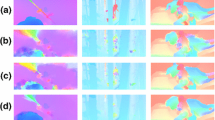Abstract
Among a broad spectrum of published methods of recognition of human actions in video sequences, one approach stands out, different from the rest by not relying on detection of interest points or events, extraction of features, region segmentation or finding trajectories, which are all prone to errors. It is based on representation of a time segment of a video sequence as a point on a manifold, and uses a geodesic distance defined on manifold for comparing and classifying video segments. A manifold based representation of a video sequence is obtained starting with a 3d array of consecutive image frames or a 3rd order tensor, which is decomposed into three \(3 \times k\) arrays that are mapped to a point of a manifold. This article presents a review of manifold based methods for human activity recognition and sparse coding of images that also rely on a manifold representation. Results of a human activity classification experiment that uses an implemented action recognition method based on a manifold representation illustrate the presentation.
Access this chapter
Tax calculation will be finalised at checkout
Purchases are for personal use only
Similar content being viewed by others
References
Cheng, G., Wan, Y., Saudagar, A.N., Namuduri, K., Buckles, B.P.: Advances in Human Action Recognition: A Survey. arXiv preprint arXiv:1501.05964v1 (2015)
Li, M., Cai, Z., Wei, C., Yuan, Y.: A survey of video object tracking. Int. J. Control Autom. 8(9), 303–312 (2015)
Wang, H., Ullah, M.M., Klaser, A., Laptev, I., Schmid, C.: Evaluation of local spatio-temporal features for action recognition. In: BMVC (2009)
Uijlings, J., Duta, I.C., Sangineto, E., Sebe, N.: Video classification with densely extracted HOG/HOF/MBH features: an evaluation of the accuracy/computational efficiency trade-off. Int. J. Multimed. Info. Retr. 4, 33–44 (2014)
Wells, R.O.: Differential Analysis on Complex Manifolds. Springer, New York (2008)
Sat, H.: Algebraic Topology: An Intuitive Approach. American Mathematical Society, Providence (1999)
Guillemin, V., Pollack, A.: Differential Topology. Prentice-Hall, Upper Saddle River (1974). pp. 2–5
Cichocki, A., Zdunek, R., Phan, A.H., Amari, S.: Nonnegative Matrix and Tensor Factorizations: Applications to Exploratory Multiway Data Analysis and Blind Source Separation. Wiley, Hoboken (2009)
Lui, Y.M., Beveridge, J., Kirby, M.: Action classification on product manifolds. In: Proceedings of the IEEE Conference on CVPR, pp. 833–839 (2010)
Hotelling, H.: Relations between two sets of variates. Biometrika 28, 321–377 (1936)
Knyazev, A.V., Zhu, P.: Principal Angles Between Subspaces and Their Tangents. Technical report TR2012-058, Mitsubishi Electric Research Laboratories (2012)
Lui, Y.M.: Human gesture recognition on product manifolds. J. Mach. Learn. Res. 13(1), 3297–3321 (2012)
Karcher, H.: Riemannian center of mass and mollifier smoothing. Commun. Pure Appl. Math. 30(5), 509–541 (1977)
Dreisigmeyer, D.W.: Direct Search Algorithms Over Riemannian Manifolds (2007). http://ddma.lanl.gov/Documents/publications/dreisigm-2007-direct.pdf
Harandi, M.T., Sanderson, C., Hartley, R., Lovell, B.C.: Sparse coding and dictionary learning for symmetric positive definite matrices: a kernel approach. In: Fitzgibbon, A., Lazebnik, S., Perona, P., Sato, Y., Schmid, C. (eds.) ECCV 2012. LNCS, vol. 7573, pp. 216–229. Springer, Heidelberg (2012)
Lui, Y.M.: Advances in matrix manifolds for computer vision. Image Vis. Comput. 30(6), 380–388 (2012)
Tuzel, O., Porikli, F., Meer, P.: Region covariance: a fast descriptor for detection and classification. In: Leonardis, A., Bischof, H., Pinz, A. (eds.) ECCV 2006. LNCS, vol. 3952, pp. 589–600. Springer, Heidelberg (2006). doi:10.1007/11744047_45
Pennec, X.: Intrinsic statistics on Riemannian manifolds: basic tools for geometric measurements. J. Math. Imaging Vis. 25(1), 127–154 (2006)
Sra, S.: Positive definite matrices and the symmetric Stein divergence. arXiv:1110.1773 (2012)
Acknowledgement
This work has been supported by the National Centre for Research and Development (project UOD-DEM-1-183/001 “Intelligent video analysis system for behavior and event recognition in surveillance networks”).
Author information
Authors and Affiliations
Corresponding author
Editor information
Editors and Affiliations
Rights and permissions
Copyright information
© 2017 Springer International Publishing AG
About this paper
Cite this paper
Michalczuk, A. et al. (2017). Manifold Methods for Action Recognition. In: Nguyen, N., Tojo, S., Nguyen, L., Trawiński, B. (eds) Intelligent Information and Database Systems. ACIIDS 2017. Lecture Notes in Computer Science(), vol 10192. Springer, Cham. https://doi.org/10.1007/978-3-319-54430-4_59
Download citation
DOI: https://doi.org/10.1007/978-3-319-54430-4_59
Published:
Publisher Name: Springer, Cham
Print ISBN: 978-3-319-54429-8
Online ISBN: 978-3-319-54430-4
eBook Packages: Computer ScienceComputer Science (R0)




